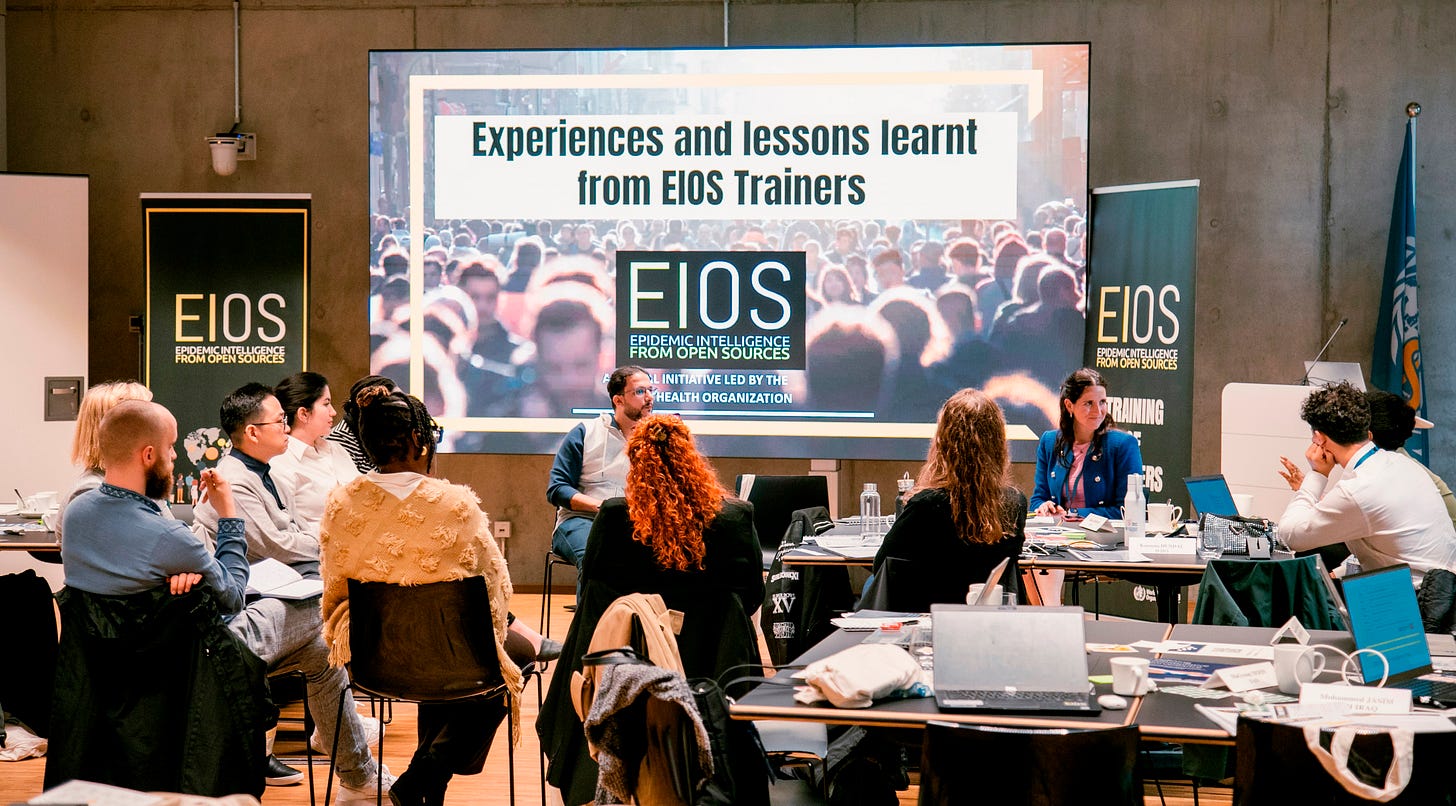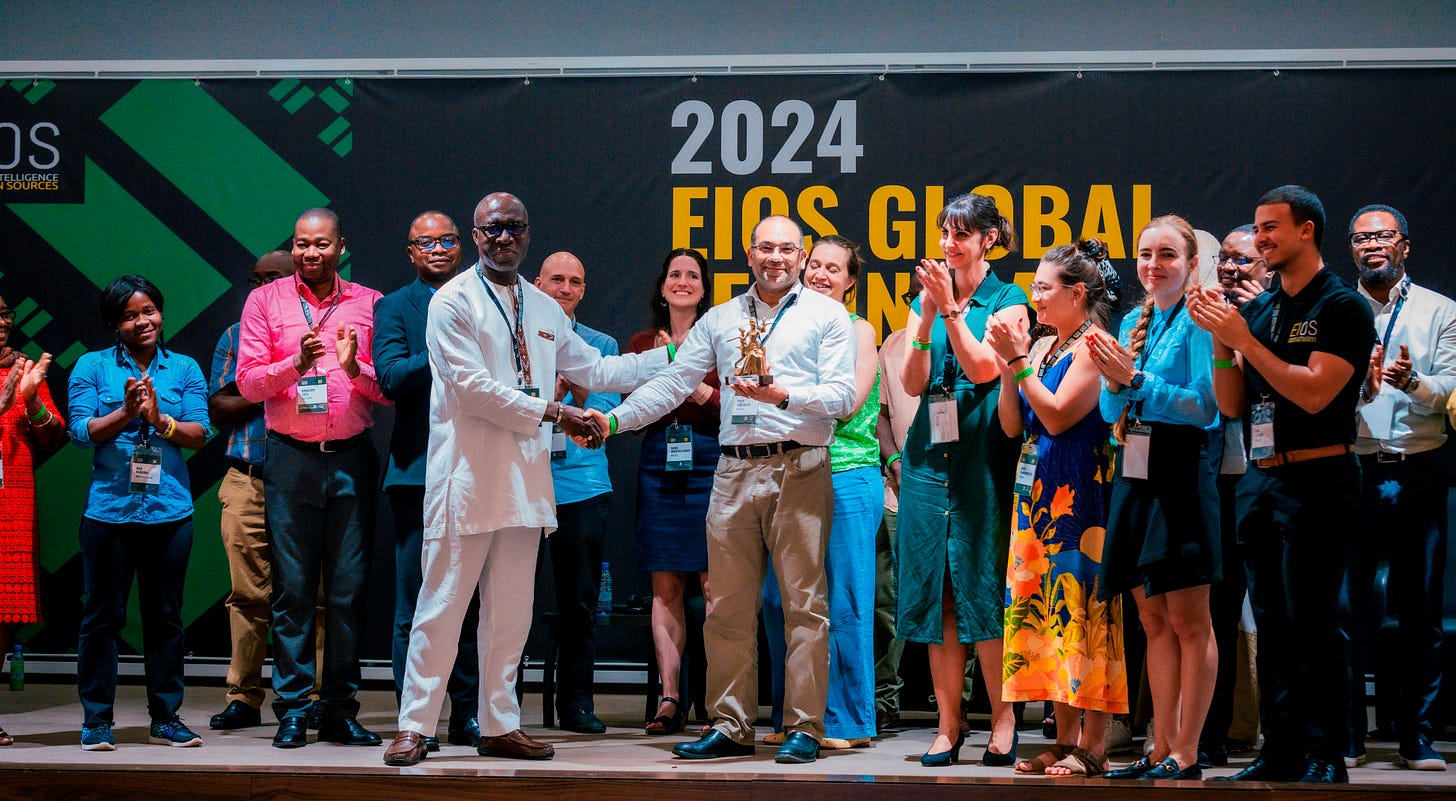Dear EIOS Community Member,
As we step into the new year, it is time to reflect on our collective achievements that have shaped 2024 and look forward to the opportunities ahead. This special edition brings you a comprehensive recap of the year, celebrating milestones, partnerships, and progress made. Collaboration lies at the heart of the EIOS initiative, and this past year has been a powerful testament to what we can accomplish together.
As we embrace 2025, we remain committed to furthering our collaborative spirit, adapting to new challenges, and building on the solid foundation laid over the past years. Thank you for being an integral part of the global EIOS community!
Welcoming new members to the EIOS community in 2024
We are delighted to share that the EIOS community continued to grow over the past year, welcoming 19 new members to our global network. This growth reflects the ever-increasing commitment to collaborative, open-source intelligence for public health emergencies. The following countries and organizations have become part of the EIOS initiative:
This diverse group of countries and organizations enriches the EIOS initiative’s capacity to enhance global health security through early detection and response to public health threats. We look forward to collaborating with our new members as we continue to advance public health intelligence (PHI) together.
Expanding workforce capacity: 2024 training milestones
In 2024 we achieved remarkable milestones in advancing EIOS and PHI training worldwide. The Global EIOS Training Team (GETT) successfully delivered 52 EIOS training and refresher workshops worldwide in multiple languages. A total of 893 participants joined the trainings, which were conducted across 40 different countries and organizations.
This year, we also welcomed the fourth cohort of EIOS trainers during the 5-day EIOS Training of Trainers workshop held at the WHO Pandemic Hub in Berlin, Germany. The workshop equipped participants to effectively deliver training on EIOS and PHI. This increased the total number of EIOS expert trainers to 111 worldwide!
Additionally, the self-paced online course Introduction to EIOS on the OpenWHO platform expanded its reach with the launch of a Spanish version, bringing the total number of available languages to five. Enrollment in the course now surpassed 2,750 learners.
We also hosted seven EIOS webinars, including community-led sessions with contributions from 13 countries and organizations. Furthermore, 22 EIOS clinics were held, emphasizing key EIOS system features to support and enhance various PHI activities.
Looking ahead to 2025, we remain committed to strengthening capacity-building efforts through comprehensive training, support materials, webinars, clinics, the transition to EIOS v2.0, ToT workshops, and much more.

EIOS GTM 2024: The Future of Public Health Intelligence
In December 2024, nearly 200 members of the EIOS community from 70 countries gathered in Senegal for the fifth EIOS Global Technical Meeting (GTM), organized in collaboration with the WHO Regional Office for Africa, the WHO Emergency Hub in Dakar, and supported by the European Commission's Health Emergency Preparedness and Response Authority (HERA). This dynamic event explored advancements in PHI, the transformative role of artificial intelligence, and strategies for future preparedness. Discussions and workshops focused on enhancing global surveillance, strengthening the PHI workforce, and introducing upcoming innovations within the EIOS system. The meeting reinforced the power of collaboration and innovation in shaping PHI, setting the stage for future progress in protecting global health. Check out the new GTM video here.
Technology updates: progress on EIOS v.2.0 system
The past year has seen extensive and exciting progress with the development of the new EIOS v.2.0 system. The EIOS Core Team (ECT), in collaboration with partners from the Joint Research Centre (JRC) of the European Commission and from Adappt, have been jointly developing this new version. EIOS v.2.0 system is based on a complete re-architecting of the portal’s core components, with new features and functionality that increase performance and scalability and enable better interoperability for future modular integration.
Currently, EIOS v.2.0 system is still in development, and is undergoing internal quality review, to ensure a complete and stable system. After this, we will be inviting selected users to participate in user-acceptance testing. We will continue to keep EIOS system users informed about transitioning to the new system, to make the change as smooth as possible with minimal disruptions to their work.
In the meantime, we will continue to keep EIOS system users informed with our ongoing progress. Once again, we would like to thank our partners JRC and Adappt, as well as the European Commission's Health Emergency Preparedness and Response Authority (HERA) for their important contributions to our joint mission.
Other progress this past year with EIOS-related technology included:
Noise Reduction is a joint endeavor between RKI and WHO to identify and de-emphasize (reduce) the amount of non-relevant articles to be scanned by EIOS system users. Improvements to the system's user interface will allow users to filter their feed based on a relevance score, which will lead to more efficient monitoring of text items.
Speech-to-Text Radio Mining is a collaboration amongst UN Office for Information and Communications Technology (OICT) and WHO AFRO, that leverages the OICT Unite Wave platform to transcribe online and FM radio stations speech into text, which is then analyzed to detect potential signals feeding into the EIOS system as a new source type.
Enhanced Webscraping is a joint Adappt and WHO work-stream to expand the number of different data formats of sources, including images and PDF documents, ease the configuration and set up of new sources, and enhance the maintainability and source management.
Anomaly Detection and Semantic Search are joint Adappt and WHO work packages to leverage various detection algorithms and approaches, including the use of large language models and vector embeddings, to focus on most relevant information and allow EIOS system users to interact and fine tune their search criteria using natural language prompts.
Strengthening detection through collaborative source expansion
The ECT, regional EIOS focal points, and communities have continued collaborative efforts to enhance the EIOS system’s detection capabilities. These efforts led to a significant expansion of source representativeness with the addition of thousands of new sources in 2024.
By January 2025, 27,700 sources fed into the portal, with over 4,300 new sources added in the past year. Maintaining these sources requires ongoing attention. To streamline this process, we are working closely with communities on a decentralization strategy.
Notably, Telegram has been included as a new source since July 2023, and the Facebook feed was restored in July 2024. Additionally, work is nearing completion to incorporate audio sources, starting with radio feeds from South Sudan and Tanzania, further enhancing the system’s reach and detection capabilities.
A new outlook on EIOS system categories
In 2024 the ECT started developing a new ontology of EIOS system categories. In the next version of the system, users will be able to find both existing and future categories organized into a framework shaped by a One Health, all-hazards approach and insights from subject matter experts. This ontology is designed to streamline browsing and grouping of categories, offering flexibility to EIOS system searches.
Where are we headed? Priorities for 2025
In 2025, the EIOS initiative will prioritize several key goals to enhance its effectiveness and sustainability. These include the rollout of EIOS v.2.0 system and the strengthening of the new technology partnership model to improve upgrades, operational tasks, maintenance, and integration efforts to the EIOS system. A more flexible training approach, an expanded pool of EIOS trainers, and improved collaboration mechanisms between communities will ensure better resource allocation and strengthen community autonomy. Additional priorities include formalizing a community Terms of Reference, enhancing user management at the community level, and allowing the ECT to adopt a more strategic rather than operational role. Finally, the initiative will focus on better enabling EIOS focal points in countries and organizations to lead and drive EIOS implementation.







